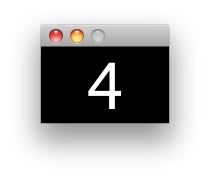Write a program that outputs this sequence of numbers infinitely. However, The Numbers must not appear in your source code anywhere.
The following is not a valid Java program to output The Numbers because The Numbers appear in its source code:
class TheNumbers {
public static void main(String[] args) {
for(int n = 0;;) System.out.println(
n == 4 ? n = 8 :
n == 8 ? n = 15 :
n == 15 ? n = 16 :
n == 16 ? n = 23 :
n == 23 ? n = 42 : (n = 4)
);
}
}
The definition of "The Numbers must not appear in your source code" is as follows:
- You must not use the numeral 4.
- You must not use the numeral 8.
- You must not use the numeral 1 followed by the numeral 5.
- You must not use the numeral 1 followed by the numeral 6.
- You must not use the numeral 2 followed by the numeral 3.
If your language ignores certain characters that can be placed between the numerals, it's not a valid substitution. So for example if your language interprets the literal 1_5 as 15, this would count as the numeral 1 followed by the numeral 5.
Alternative bases are included in the restriction, so for example:
- Binary 100 can't be used as a substitute for 4.
- Octal 10 can't be used as a substitute for 8.
- Hexadecimal F can't be used as a substitute for 15.
Therefore, the following is a valid (but not very inspired) Java program to output The Numbers because The Numbers do not appear in its source code:
class TheNumbers {
public static void main(String[] args) {
for(int n = '*';;) {
System.out.println(n -= '&');
System.out.println(n *= 2);
System.out.println(n += 7);
System.out.println(++n);
System.out.println(n += 7);
System.out.println(n += 19);
}
}
}
Note that in that program, '*' and '&' are substituted for the integers 42 and 38, because otherwise the numerals 4 and 8 would appear in its source code.
The definition of "outputs the sequence infinitely" is open to interpretation. So, for example, a program that outputs glyphs getting smaller until they are "infinitely" small would be valid.
Kudos if you are able to generate the sequence in some way that's not basically hard-coding each number.
- Deriving it to a formula. My impression is there is not one but maybe there is or it can be faked.
- Fixing a pseudo-random generator to return the sequence.
This is a popularity contest, so be creative. The answer with the most up votes on March 26th is the winner.



This isn't an interesting question, IMHO, since the solution is pretty trivial. Please post in the sandbox next time.would be way better thanThis is a stupid question., but that's just my personal opinion. \$\endgroup\$